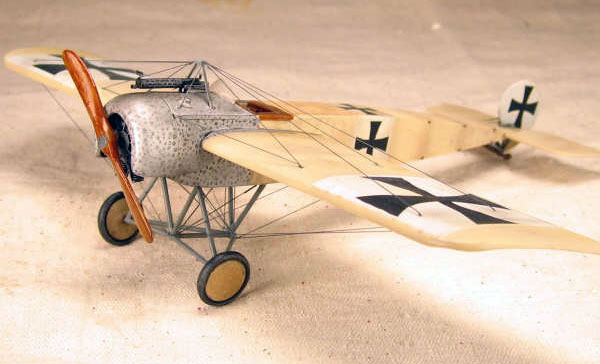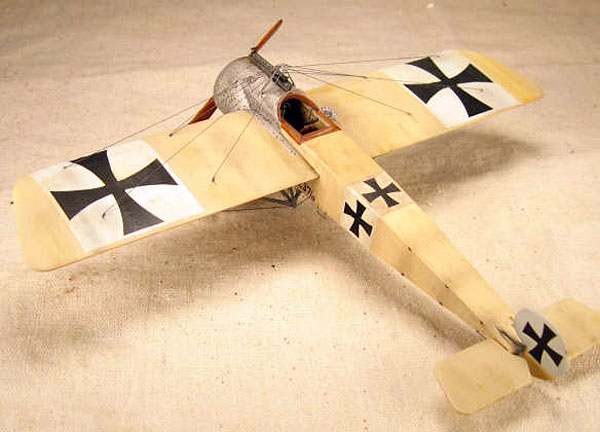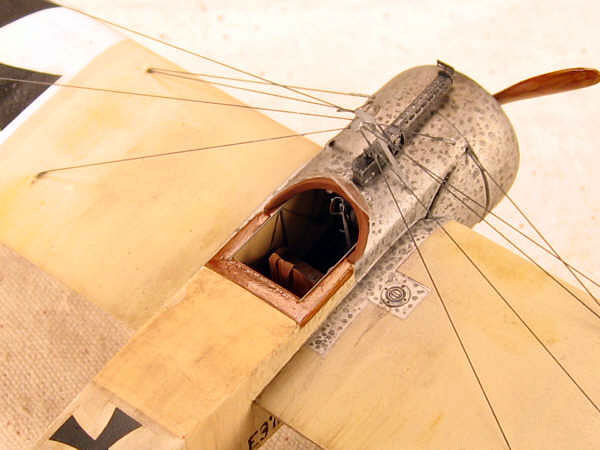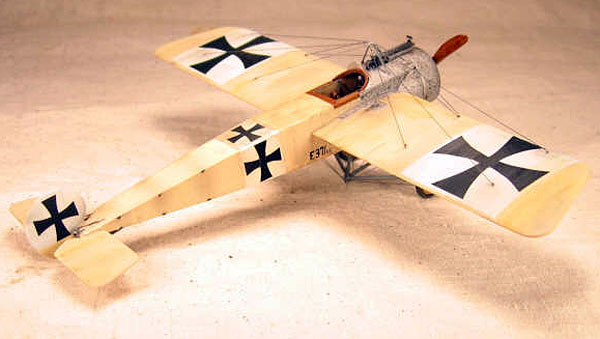|
Eduard / Flashback's 1/48 scale
Fokker Eindecker E.II
by
Scott Lyle
|

|
|
Fokker Eindecker E.II |

Roden's 1/32 scale Albatros D.III is available online from
Squadron.com
For a while one of my dreams has been to build a 1/48 collection of
the world’s greatest fighters in chronological order, starting with
World War 1 and ending with the present time. Obviously a list like that
is highly subjective, but creating such a list is part of the fun. I
decided to start off with the German Fokker Eindecker, the aircraft that
spawned the “Fokker Scourge”, a period where the German Air Force gained
a high degree of air superiority over the battlefields during the early
part of World War I.

One of the features that made the Eindecker so successful was that it
was one of the first aircraft that featured a machine gun that was
synchronized to fire through the arc of the propeller. This allowed the
machine gun to be mounted on the centerline of the aircraft right in
front of the pilot, greatly simplifying the task of shooting down the
enemy in the process. All the pilot had to do (relatively speaking) was
line up his fighter with the enemy and pull the trigger. The Allies had
no immediate equivalent to Fokker’s synchronizing device, and Allied
pilots paid dearly because of it.
Eindecker pilots began to dominate the skies during the summer of 1915
and continued well into the spring of 1916 by which time Allied designs
like the Nieuport 11 and 17 began to wrest air supremacy back from the
Germans. Famous German Aces like Oswald Boelcke and Max Immelmann will
be forever associated with the Eindecker. I decided to model Eindecker
E.II, “E37/15”. This particular aircraft was flown by both of both of
those great aces at different times during the fall of 1915.
The Eduard/Flashback kit is somewhat basic when compared to today’s
state of the art. It is boxed as an E.III, but can be easily built as an
E.II as those two aircraft were dimensionally the same.

Construction is straightforward and even the large amount of rigging
was easy to handle. I anchored one end of the line to the top center
post and then ran it out to one hole in the wing, down through the wing,
across to the other side, back up through the wing, and back to the top
center post again. By repeating this loop three more times the rigging
was completed much quicker than I thought it would be.
Painting,
Markings & Weathering
|
 The
model was painted Testor's Acrylic Radome Tan to simulate Clear Doped
Linen. The kit’s decals were used for the large crosses, and I
hand-painted “E37/15” on both sides of the fuselage. I much prefer
decals to hand-painting... The
model was painted Testor's Acrylic Radome Tan to simulate Clear Doped
Linen. The kit’s decals were used for the large crosses, and I
hand-painted “E37/15” on both sides of the fuselage. I much prefer
decals to hand-painting...
To simulate the swirled metal finish on the sheet metal cowling I
placed dots of Testor's Steel over the Testor's Aluminum base. Though
I’m not in love with the effect, it looks reasonably good to me, and
breaks up the monotony of the all-beige paint scheme.
To weather the Eindecker I placed some dots of Burnt Umber, Lamp Black,
and Burnt Sienna oil paint all over the beige surfaces and then spread
them around in all directions using thinner to create a subtle, grimy
look. On the vertical surfaces I tried to create a downward streaking
effect.

A very thin mix of Tamiya Black and Red Brown was sprayed in subtle
bands along the fuselage to add to the weathering and the model was
done.
References
-
Osprey Publications, Aircraft of the
Aces #73, “Early German Aces of World War 1”
-
Squadron/Signal Publications,
Aircraft in Action #158, “Fokker Eindecker in Action”
Model, Images and
Text Copyright © 2007 by Scott Lyle
Page Created 28 August, 2007
Last Updated 24 December, 2007
Back to HyperScale
Main Page
|
Home
| What's New |
Features |
Gallery |
Reviews |
Reference |
Forum |